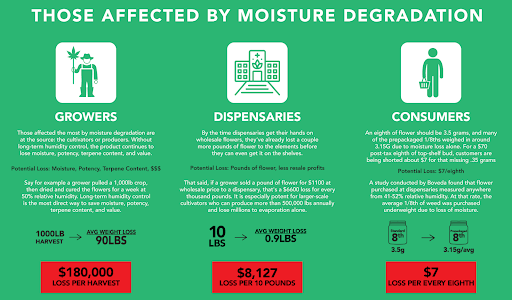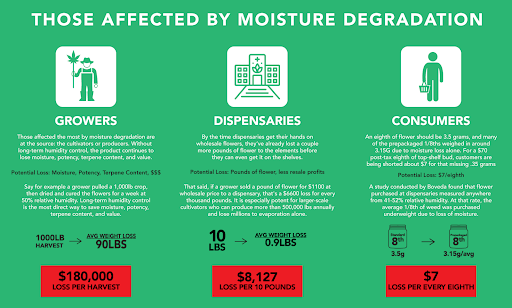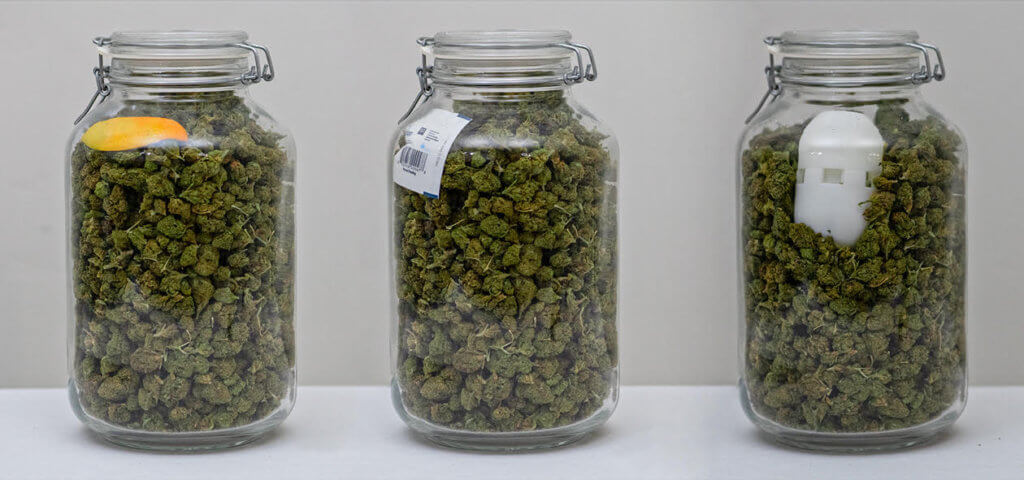Member Blog: Evaporation is Costing the Cannabis Industry Millions. Here’s Everything You Need to Know.
HempMarijuana Laws, Regulations, & Politics October 19, 2021 MJ Shareholders 0

As cannabis ages, many of its therapeutic components degrade and transform into less effective compounds. Here’s everything you need to know about cannabis degradation, how the compounds are affected, and a few ways to restore products that have seen better days.
How long do cannabis and hemp buds stay fresh?
Cannabis is made up of various naturally occurring chemical compounds, including cannabinoids, terpenes, flavonoids, lipids, and fibers. Just like all organic materials, these components break down and degrade over time.
Think about your favorite fruits. Fresh oranges for example, will eventually rot as they age and their molecular compounds break down. When exposed to light, their outer layers start to spoil in a process known as photodegradation that causes discoloration and loss of flavor, vitamins, and proteins.
Further enzymatic chemical reactions occur and transform water, vitamins, and other molecules into different formations that can degrade even further with added heat or moisture loss. The oranges will lose their zesty aroma, sweet flavor and will be more susceptible to microbes, which will eventually cause the fruit to spoil. That said, dried fruits can be stored in a pantry for much longer before they’re no longer safe to eat as the “conditioning” or “curing” process can make them shelf-stable for up to a year.
Like dried fruits, cannabis and hemp undergo a curing process that helps to equalize the moisture content among the buds. This process reduces the risk of mold and spoilage while keeping the flower fresh, flavorful, and potent. Following this process correctly can keep cannabis and hemp flower “fresh” for 3-6 months or longer if stored properly. However, even with the most disciplined processes and practitioners, eventually, all organic materials begin to break down from exposure to the elements.
Much like our dried oranges example above, cannabis and hemp stored in suboptimal conditions are more susceptible to “rot” and can lose everything that makes them special. Light and temperature can contribute to the degradation of these natural features, but the biggest factor in terpene degradation is moisture content – or the lack of it. Moisture helps to preserve these compounds for prolonged periods of time.
What happens to the terpene profile and moisture content of cannabis and hemp over time?
On average, 12% of all cannabis and hemp biomass is moisture. As that moisture evaporates, it takes valuable terpenes and other essential oils with it leading to dry and brittle plant matter. Terpenes are naturally occurring chemical compounds found in plants that are responsible for their unique aromas and flavors. They also add and help preserve moisture. Cannabis and hemp contain an unparalleled profile of 100+ different terpene isolates that all evaporate at different rates based on temperature and humidity.
While live terpenes smell most potent during the flowering phase, terpene degradation starts immediately after the buds are cut from the stem. This happens because terpene oils, especially the most pleasant ones found in tiny amounts, tend to have low-temperature tolerance thresholds and evaporation levels. Once these terpenes have evaporated they will not be replaced by the living plant after cutting. This is why curing and storage is so important post-harvest. The curing stage allows for the terpene profile to mature but, even during this process terpene potency will continue to weaken.
When flower is stored below 50-55% RH (Relative Humidity) it leads to the fragile cannabinoid and terpene-rich trichomes to become brittle and break off. This lowers potency and causes the terpenes to evaporate with the remaining moisture content. The longer cannabis and hemp are stored in these conditions, the less potent, flavorful, and aromatic they become. On the other hand, going over 65% RH is in the danger zone of where mold can thrive and wreck a harvest with bona fide rot.
Who is affected by terpene and moisture degradation?
In short, terpene degradation affects everyone. Growers see the most significant profit loss as evaporation can take pounds and pounds of cannabis away from their final numbers in as little as 14 days. Dispensaries also see a loss of profit as the flowers dry during transit and while sitting on the shelf, making it so that they paid for more than what they actually ended up selling to their customers.
In the end, consumers are eventually the ones left holding the bag. Not only is the flower at its highest degradation stage by the time it gets into their hands but loss in weight can turn a pre-packaged 3.5g eighth into 3.15 grams or less.
The example in the graphic below outlines how moisture degradation affects both yields and profit.

How can you stop your cannabis from drying out?
Using orange peels and pieces of bread for rehydration used to be the norm in what feels like ages ago. In the more recent past, cultivators, dispensaries, and consumers alike have relied heavily on moisture-control products like Boveda brand or Boost brand humidity packs. These products can help to keep moisture in the 50-65% optimal range. However, they do have their drawbacks.
The humidity packs have a definite shelf life and in extremely dry conditions, they can’t keep up with the rate of evaporation – almost to the point where many claim they don’t actually work. While they can help maintain some moisture content, they can’t rehydrate buds that have gone below the 50% humidity threshold. This makes them closer to a moisture stabilizer of sorts than a moisture booster or replenisher. Beyond using the aforementioned “ancient ways” to rehydrate abused cannabis flower, these packs have been the only option available to the industry.

However, recently a new product on the market called the “Cure-Egg” has been making waves and has been proving invaluable when it comes to product reclamation and preservation. The Cure-Egg’s patented ergonomic design and utility works in a similar way to the hydration packs but boasts the ability to rapidly rehydrate biomass in a few days’ time while staying under the mold growth threshold.
In addition to its ability to quickly rehydrate cannabis and hemp flower it also comes with the added benefit of terpene infusion to counteract terpene loss. Oftentimes beautiful-looking flower is grown but it somehow misses the mark when it comes to the nose. This product could be a game-changer for farms, dispensaries or anyone sitting on older product that has lost its zing from prolonged storage or errors in production.
Users are quickly finding out that they can take less than premium flower destined for the world of “affordable pre-rolls” and easily turn them into a flavor and aroma-packed desirable product that doesn’t have to come at a discounted price. Time will tell if this product will become the next industry staple but one thing is for certain, innovative new products are definitely shaking things up.
Peak Supply Co provides the first true all in one solution providing terpenes, vape cartridges, package design and production, helping clients progress from starting creative to finished product.
MJ Shareholders
MJShareholders.com is the largest dedicated financial network and leading corporate communications firm serving the legal cannabis industry. Our network aims to connect public marijuana companies with these focused cannabis audiences across the US and Canada that are critical for growth: Short and long term cannabis investors Active funding sources Mainstream media Business leaders Cannabis consumers










No comments so far.
Be first to leave comment below.